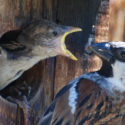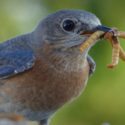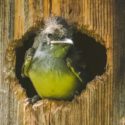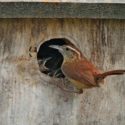 Photo ©
Keith Williams
Photo ©
Keith Williams

Invasive Species in Nest Boxes
In 2018, NestWatch sent out
an online survey to investigate how many people had experience with non-native
birds in their nest boxes. The survey explored peoples’ knowledge of House
Sparrows and European Starlings, both non-native species in the United States
and Canada, where the survey took place. We were interested in peoples’
attitudes towards managing non-native species, especially if people encountered
them in their monitored nest boxes.
We are grateful to the many people who took time to fill out our survey.
Because of you, we have a better understanding of the impact of nest
usurpation, and how people are playing a role in reducing the number of nests
that fail due to usurpation by non-native species. Find out what we learned in our
latest blog post.

Feeding Worms Keeps Flies Away
Check out this recent study, showing that Eastern Bluebird nestlings who had access to more food during the breeding season also had increased immune responses to parasitic fly larvae (blowflies) and better survival. The study also suggests that feeding mealworms (which are not worms but beetle larvae) earlier in the season had more of an effect. So, if cost is limiting when you provide mealworms, prioritize providing them early in the season. We recommend that if you provide both food and nest boxes, place feeders some distance away from your nest boxes to avoid attracting predators to the nest(s).

We Want Your Flycatcher Photos!
As a reminder, NestWatch is
still seeking photos of Great Crested Flycatcher and Ash-throated Flycatcher
nests for our study on nest materials
in these species. For reasons we don’t yet understand, these two species often
incorporate shed snake skins into their nest materials.
We’re asking NestWatchers to please use the photo upload tool on the mobile app
or on our website to upload photos of nests (including nests lacking snake
skin). Using the photo upload tool in the data entry pages automatically links
the images to the correct nesting data.
Learn more about how to participate
in the study and how to find these flycatchers’ nests here.

Kansas Data Haul
This month we bulk-uploaded 357 nest records courtesy of Vince Petrillo, who submitted the data on behalf of the Kansas State Extension Master Naturalists. These data from hundreds of nest boxes covered eight species from 2019. Great work, Kansas State!